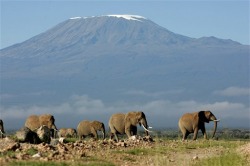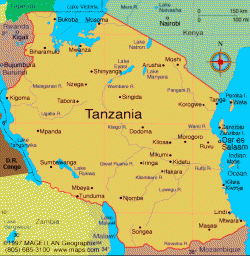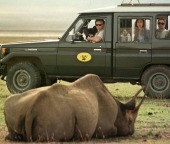Tanzania: Geography and Environment
The Wildest Place In Africa

Sarah Schuette
World History-Hjelmgren
5/5/09 Period 1
Tanzania is located in eastern Africa, situated on the Indian Ocean. “Three times larger than New Mexico” (http://www.infoplease.com/ipa/A0108028.html), it is home to some of the worlds’ most marvelous landforms, such as Mt. Kilimanjaro, the Olduvai Gorge, and the Ngorongoro Crater. It is home to hundreds of diverse species of animals. Its beautiful landscape makes it an ideal tourist spot, and there are many who attempt to trek up the continents’ tallest mountain. Others go on safari, viewing absolutely magnificent animals in their natural habitats, and see numerous unique types of foliage such as the Baobab tree and Acacia tree while experiencing the hot but varied climate of the country.
Mt. Kilimanjaro is a massive mountain lying in the northeastern part of Tanzania. It has been measured to be approximately “5,891.8 meters (19,330 ft), its highest peak referred to as Uhuru Peak, which is one of the Seven summits.” (http://www.tanzaniaparks.com/kili.html.) The Olduvai Gorge is a second example of Tanzanian wonder. It has been the site for numerous archeological digs over the years, and has been known for been the resting place of numerous hominids. (http://www.sfu.ca/archaeology/museum/olduvai/index2.html) Another landform is the Ngorongoro Crater. The Ngorongoro Crater was formed when a volcano collapsed on itself, and has become home to many of the country’s creatures.
Tanzania is situated in the eastern half of Africa. “It is bordered by Kenya, Uganda, Burundi, Rwanda, Congo, Mazambique, Zambia and Malawi. It is also home of 3 large lakes; Lake Victoria, Lake Tangankika, and Lake Nyasa. (http://www.infoplease.com/ipa/A0108028.html)
Tanzania is one of the best places in Africa to see wildlife, especially mammals and birds. It is one of the few places left in the world where the rare and majestic Black Rhino can still be sighted. Tanzania has been very productive in making efforts to conserve wildlife, but species numbers still decline do to poachers and other threats. There are lions, cheetahs, elephants, different ungulates, (zebra, springbuck, gazelles, etc.) hippo, jackals, leopard, and so on. They are known for thriving largely in the Ngorongoro Crater and provide insight to the lives of so many different species. They roam freely, and some have grown accustomed to people to the point where they migrate through the local villages. “Because it is actually a conservation area, the tribes there are permitted to allow their livestock to graze and water, thus promoting the mutual relationships between the domesticated livestock and the wildlife.” (http://www.sfu.ca/archaeology/museum/olduvai/index2.html)
Due to its ideal location on the Indian ocean, it’s notable amount of geographical beauties, and the massive diversity of wildlife that exists there, it is reasonable to feel that Tanzania is an impressive country. It is home to some of the world most precious creatures, and due to its enormous magnitude of different landforms, one can safely say that Tanzania has the most beautiful environment of all of Africa.
World History-Hjelmgren
5/5/09 Period 1
Tanzania is located in eastern Africa, situated on the Indian Ocean. “Three times larger than New Mexico” (http://www.infoplease.com/ipa/A0108028.html), it is home to some of the worlds’ most marvelous landforms, such as Mt. Kilimanjaro, the Olduvai Gorge, and the Ngorongoro Crater. It is home to hundreds of diverse species of animals. Its beautiful landscape makes it an ideal tourist spot, and there are many who attempt to trek up the continents’ tallest mountain. Others go on safari, viewing absolutely magnificent animals in their natural habitats, and see numerous unique types of foliage such as the Baobab tree and Acacia tree while experiencing the hot but varied climate of the country.
Mt. Kilimanjaro is a massive mountain lying in the northeastern part of Tanzania. It has been measured to be approximately “5,891.8 meters (19,330 ft), its highest peak referred to as Uhuru Peak, which is one of the Seven summits.” (http://www.tanzaniaparks.com/kili.html.) The Olduvai Gorge is a second example of Tanzanian wonder. It has been the site for numerous archeological digs over the years, and has been known for been the resting place of numerous hominids. (http://www.sfu.ca/archaeology/museum/olduvai/index2.html) Another landform is the Ngorongoro Crater. The Ngorongoro Crater was formed when a volcano collapsed on itself, and has become home to many of the country’s creatures.
Tanzania is situated in the eastern half of Africa. “It is bordered by Kenya, Uganda, Burundi, Rwanda, Congo, Mazambique, Zambia and Malawi. It is also home of 3 large lakes; Lake Victoria, Lake Tangankika, and Lake Nyasa. (http://www.infoplease.com/ipa/A0108028.html)
Tanzania is one of the best places in Africa to see wildlife, especially mammals and birds. It is one of the few places left in the world where the rare and majestic Black Rhino can still be sighted. Tanzania has been very productive in making efforts to conserve wildlife, but species numbers still decline do to poachers and other threats. There are lions, cheetahs, elephants, different ungulates, (zebra, springbuck, gazelles, etc.) hippo, jackals, leopard, and so on. They are known for thriving largely in the Ngorongoro Crater and provide insight to the lives of so many different species. They roam freely, and some have grown accustomed to people to the point where they migrate through the local villages. “Because it is actually a conservation area, the tribes there are permitted to allow their livestock to graze and water, thus promoting the mutual relationships between the domesticated livestock and the wildlife.” (http://www.sfu.ca/archaeology/museum/olduvai/index2.html)
Due to its ideal location on the Indian ocean, it’s notable amount of geographical beauties, and the massive diversity of wildlife that exists there, it is reasonable to feel that Tanzania is an impressive country. It is home to some of the world most precious creatures, and due to its enormous magnitude of different landforms, one can safely say that Tanzania has the most beautiful environment of all of Africa.
Bibliography:
“Tanzania.” Infoplease. 2005. HighBeam research. 30 April 2009.
http://www.infoplease.com/ipa/A0108028.html
This sight was helpful in that I found a good decription of the country’s location and the countries around it.
“Mount Kilimanjaro National Park.” 2008. Tanzania National Parks. 3 May 2009.
http://www.tanzaniaparks.com/kili.html
This site provided me with a good deal of information on some of Tanzania’s famous landforms, especially Mt. Kilimanjaro.
“Olduvai Gorge 1969.” 2 May 2009.
http://www.sfu.ca/archaeology/museum/olduvai/index2.html
This was a useful sight in regards to the Olduvai Gorge and some of Tanzania’s climate.
http://www.infoplease.com/ipa/A0108028.html
This sight was helpful in that I found a good decription of the country’s location and the countries around it.
“Mount Kilimanjaro National Park.” 2008. Tanzania National Parks. 3 May 2009.
http://www.tanzaniaparks.com/kili.html
This site provided me with a good deal of information on some of Tanzania’s famous landforms, especially Mt. Kilimanjaro.
“Olduvai Gorge 1969.” 2 May 2009.
http://www.sfu.ca/archaeology/museum/olduvai/index2.html
This was a useful sight in regards to the Olduvai Gorge and some of Tanzania’s climate.
Last updated by: Sarah Schuette 05/25/09




